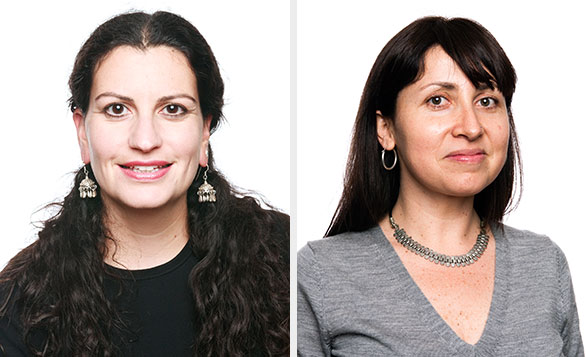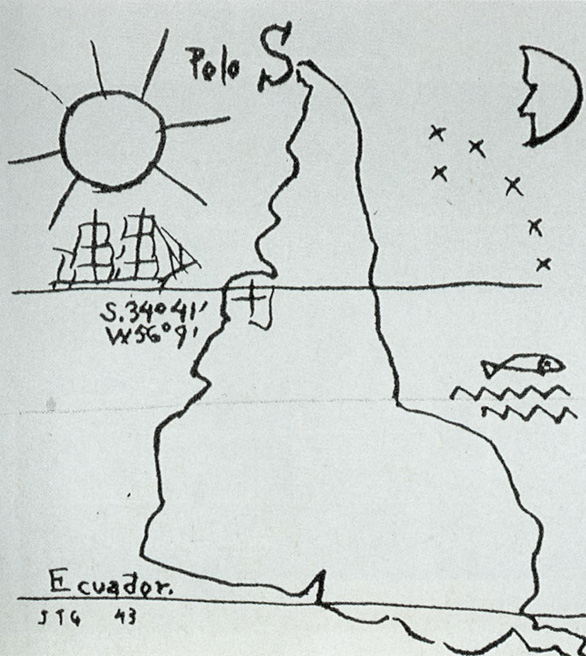
Nassim Assefi and Gabriella Gómez-Mont curated the TEDGlobal 2013 session “The World on Its Head.”
Session 6 of TEDGlobal 2013 has a captivating title: “World on Its Head.” Guest curated by Nassim Assefi and Gabriella Gómez-Mont — both from the inaugural class of TEDGlobal 2009 Fellows — the session will be a chance to turn our conceptions of the Middle East and Latin America upside down, and to rethink staid assumptions about politics, religion, art, architecture, peacemaking and more.
Here, the TED Blog asks Assefi and Gómez-Mont to share what inspired the session and how they went about picking speakers.
Where did the theme “The World on Its Head” come from?
Nassim Assefi: Gabriella and I brainstormed, trying to tie together our two regions. What is the zeigeist in each of our regions? The undercurrents? What do they have in common? How have they been underestimated? Misunderstood? What is their hidden potential? We settled on “The World On Its Head” after viewing a wonderful map of the world with the South facing upward. That visual became a metaphor for rethinking deeply held assumptions and views of the world and sitting with the discomfort of a new idea until the brain adjusts.
Gabriella Gómez-Mont: For me, the idea of “The World on Its Head” rings strongly and intimately with moments in life when I had to truly rethink important things so deeply that the former map no longer works, no longer matches the new reality. That moment, pause, gap, chaos of no longer understanding anything because one fundamental part of understanding crumbles — it’s one of the most enigmatic and profoundly human moments one can go through.
It is both so strangely beautiful and tremendously brutal to rethink once unshakable truths. No wonder all of us, collectively and individually, try to make the world sit still and force maps to remain the same for centuries even when they no longer work. But in the end, that moment of confusion is a fundamental part of every transformation, adventure, and reconstitution — a pure turbulent threshold between paradigms. And then many new possibilities surface after finding one’s footing again in an upside-down world.
How did the guest curation come about?
Assefi: I had been pitching speaker ideas to [TEDGlobal curator] Bruno Giussani since the moment I met him, and many of those suggestions have made it to the TED stage. I play that role at TEDMED, too. In August 2012, we received a marvelous email invitation out of the blue from Bruno to guest curate/host a session at TEDGlobal. There are more than 300 TED Fellows from around the world, each doing amazing work, and no TED Fellow had ever guest curated a session at TED, so this is an incredible honor.
Gabriella and I were chosen in part because we work in, and come from, distinct regions of the world — I represent the Middle East/Central Asia, and Gabriella Latin America. I’m an internist and global women’s health specialist (most recently tackling maternal mortality in Afghanistan). I also write novels, work on civic peace-oriented projects in the Middle East, defend human rights from a medical angle, and am a feminist activist, a single mom, and a diehard TEDhead. Gabriella is an artist, a documentary filmmaker, a curator for the arts in Latin America, and now head of a civic think tank/laboratory for Mexico City.
I represent the sciences/health, literature, and global politics; she is the arts expert, the design/architecture person, a cultural force. We have different styles of working, but in reality, we overlap quite a bit. I speak Spanish and have worked in Central America. She has traveled in the Middle East. We’re both polyglots, crazy dancers, and global citizens, though we have strong predilections for our regions of origin.

The map that inspired the session, “The World on its Head.”
What’s the thrust of the session?
Assefi: It’s about discarding assumptions about the Middle East, Latin America, and the way you think the world works in exchange for groundbreaking ideas that will hopefully inspire you to rethink politics, religion, art, peacemaking, the role of sports, underestimated economies and architecture, and even toxic environments.
Gómez-Mont: Exactly, that is a great description. I was interested in reformulating and rethinking certain gray areas we take for granted, and I wanted to focus on Latin America, on certain places and subjects that could be explored more thoroughly. We sought to make our speakers complement each other, understand how we could weave certain threads among individual narratives, regions and diverse disciplines. And diversity — of age, country of origin, religion, and so on — was important to us.
Can you describe your speakers?
Assefi: All are global citizens/multicultural. Each of them has taken on courageous work. The lineup include: architect and urbanist Teddy Cruz; explorer, writer and filmmaker Holly Morris; economic policy innovator Juan Pardinas; historian/political scientist Trita Parsi; performance artist Tania Bruguera; accidental theologist Lesley Hazleton; and founder of the Beirut Marathon, May El-Khalil.
We found our musician through two other TEDFellows, Meklit Hadero and Esra’a al Shafei. Dina el Wedidi is one of Meklit’s Nile Music artists and is featured in Esra’a’s MidEastTunes app. Through the Rolex Mentor and Protegee Arts Program, Dina has been paired with the famous Brazilian musician, Gilberto Gil. Dina seemed like a poetic fit for our session — the TED Fellow-link to discovering this brazen, beautiful, young woman singer-songwriter from the Middle East, who found her audience during the Arab Spring and is being influenced and mentored by a legendary Latin American musical force.
But we don’t want to give away our speakers’ topics. It’s more fun if you are surprised by our session. At a TED conference, one generally doesn’t know what each speaker’s idea worth spreading will be until show time!
Which speakers do you think are going to knock our socks off? Why?
Assefi: That’s a cruel question, like asking a mother to choose the favorite between her children! The truth is, if curated well, different speakers will wow different people. It depends on what’s happening in your life, what you’ve been thinking about lately, and how open you are to certain ideas. Of the four I’ve chosen, I can imagine each one of them blowing you away. I predict Gabriella feels the same.
Gómez-Mont: I feel the same. And one never knows until that fateful day when the crowd goes silent and the curtain goes up what will happen in that space between those words on paper and the voice on stage — between the careful planning and the happily reckless, often serendipitous, many times shifting, sometimes accomplice or sometimes trickster — reality.
TED Global, themed “Think Again,” kicks off on June 10 in Edinburgh, Scotland. See the full list of speakers, and get lots more information about attending at the conference website. And stay tuned to the TED Blog where we will be bringing you live coverage of the conference.
Comments (2)
Pingback: TEDGlobal Simulcast at SunRay Cinema, June 13th | TEDxJacksonville
Pingback: World on Its Head: The speakers in session 6 at TEDGlobal 2013 | Krantenkoppen Tech